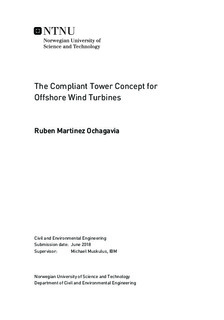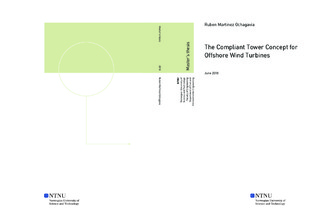| dc.description.abstract | Offshore wind turbines are getting larger and the water depths where they are located are getting deeper as well. This causes problems of eigen frequencies for rigid structures where a jacket structure could be too expensive in depths around 50 meters. At this depth, floating structures will not be efficient due to the hydrodynamic behaviour and the mooring system for this depth can be challenging. That is the reason why compliant structures are analysed for depths around 50 meters due to their low eigenfrequencies of the structure while having a load path into the seabed.
For the realization of the thesis, two main tasks have been done. First, the implementation of a code to calculate all the steps in the design of an offshore wind turbine. This method has covered from the determination of natural frequencies of the structure and the solution of the dynamical equation of dynamics to obtain displacements depending on time for different environmental conditions in the tower, to the obtention of the force response of the structure and the code checks necessary to satisfy the guidelines and requirements for Ultimate Limit State, Fatigue Limit State and Serviceability Limit State. This methodology will be the base for a preliminary design of the structure. The main theory to develop this program has been the finite element method and the type of beam used for the calculation can be decided by the user between the Bernoulli beam and the Timoshenko beam.
The second main task is the design of a compliant tower for a specified site location using the methodology for preliminary design create beforehand. The location of the compliant tower is the Dutch North Sea and an analysis has been performed to try to locate the optimal natural frequencies for the structure based on the frequencies of the environmental loads acting on the tower. Different tests have been done and different options for the design have been studied like the use of guy cables to control the displacements, the incorporation of a mass trap in the structure and changes in geometrical aspects have been done to achieve a lower natural frequency. These changes are the length from the seabed level to the rotor-nacelle assembly and the slenderness of the monopile studied. All the elements introduced in the code can be changed easily and therefore, this program will be useful for many different cases.
The rotor-nacelle assembly used has a rating of 5 MW and a rotor radius of 126 m. Possibility of a larger wind turbine has been studied to reduce even more the natural frequencies.
Another important factor like the soil-tower interaction has been also considered and the analysis of the behaviour of the soil has been done according to p-y curves. Differences in behaviour for different types of soil has been evaluated.
After arriving to a final design of the compliant tower satisfying all the limit states evaluated, the results of the program are shown and it can be seen that the representation of deflections are reliable while the data for bending moment reactions and shear forces is not completely exact due to the higher influence of bending strain energy than for the shear energy for high flexibility members.
Although further research is needed about compliant towers, this preliminary analysis is satisfactory to ensure that compliant towers could become much more common in the future. | |

